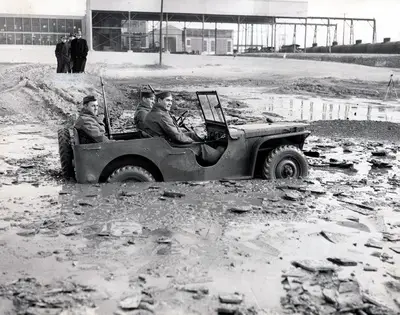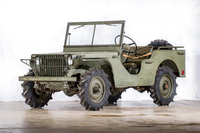America's Oldest Known Jeep Celebrates Its 75th Birthday - And It's Actually A Ford +VIDEO
 The 1940 Ford Pilot Model GP-No. 1 Pygmy, during initial testing after delivery to the U.S. Army Quartermaster Corps at Camp Holabird in Baltimore on 23 November 1940. |
 1940 Ford Pilot Model GP-No.1 Pygmy |
It is said that "success has many fathers" and so it was in the case of the U.S. military "1/4 ton, four-wheel-drive reconnaissance truck" that became popularly known as the "jeep." In June 1940, the U.S. Army sought to develop an agile lightweight vehicle to facilitate infantry and other troop movements. The principle initial parties involved were the U.S. Army; American Bantam Car Company (Butler, Pennsylvania); Willys-Overland Motor Co., Inc. (Toledo, Ohio); and later the Ford Motor Company (Detroit).
The first prototype "pilot model" was produced by American Bantam and delivered to Camp Holabird in Baltimore on Sep. 23, 1940. Willys-Overland and Ford were able to observe the American Bantam pilot prior to completing their pilot models. On Nov. 11, 1940 Willys-Overland delivered the first of two "Quad" prototype pilot models. On Nov. 23, 1940, the Ford Motor Company delivered two "Pygmy" prototype pilot models - the first with a Ford body (serial number GP-No. 1) and the second (serial number GP-No. 2) with a body produced by the Edwin G. Budd Manufacturing Co. (Philadelphia). Of the five pilot models produced by the three manufacturers only the two Ford pilot models are known to survive making the Ford Pilot Model GP-No. 1 America's oldest known "jeep."
Retired U.S. Army Lieutenant General Roger C. Schultz, President, Army Historical Foundation said: "the jeep was pivotal during WWII; became an indispensable part of the U.S. Army efforts for decades; quickly transitioned to civilian use; and became a global icon for America. GP-No. 1, the oldest known jeep, is worthy to be recognized as an important American cultural treasure."
The 1940 Ford Pilot Model GP-No. 1 Pygmy is owned by the U.S. Veterans Memorial Museum in Huntsville, Ala. where it is on display. GP-No. 1 was the only Ford pilot model tested at Camp Holabird and it was eventually returned to Ford. In 1948, Henry Ford II, then President of the Ford Motor Company, donated GP-No. 1 to The Henry Ford Museum. In September 1982 GP-No. 1 was sold to Randall Withrow at a Henry Ford Museum auction. Mr. Withrow said, "I remember I could not believe that the Ford Pygmy was being sold and I was the winning bidder. I later founded the U.S. Veterans Memorial Museum and donated the Ford Pygmy as an important centerpiece to the collection. At the museum today, we continue to carefully maintain GP-No. 1 in its unrestored condition."
The Ford Pilot Model GP-No. 1 Pygmy is historically significant based on: (i) its testing at Camp Holabird in late 1940 which was an important event in the development of the "jeep;" (ii) its design contribution to the eventual standard military "jeep;" (iii) being the first prototype produced by Ford and oldest known example of the "jeep;" and (iv) its mostly unrestored condition. The Ford Pilot Model GP-No. 1 Pygmy design is perhaps most notable as the first "jeep" prototype to feature a flat slatted front grille with integrated headlights which went on to become an iconic design element of the standardized mass produced WWII "jeep" and subsequent commercial versions.
In 1941, the U.S. military contracted Willys-Overland and Ford for mass production of a standardized "jeep" that incorporated designs from each of the original three manufacturers. The final standard military design Willys-Overland MB used the "Go-Devil" four-cylinder engine as the standard engine. Ford manufactured the Willys-Overland engine under license for its GPW model ("W" for Willys). The Willys-Overland MB and Ford GPW models we near identical with interchangeable parts. American Bantam did not receive a contract to produce any of the standardized WWII "jeep" vehicles. The table below details the total production of the military "jeeps" prior to and during WWII.
Following the war, Willys-Overland commercialized the "jeep" creating a civilian version known as the "CJ." On Jul. 13, 1950, Jeep® became a registered trademark of Willys-Overland. During the late 1940s the company launched the CJ-2A, CJ-3A, Jeep Station Wagon, Jeepster, pick-up and other trucks. Willys-Overland was sold to Kiaser Motors in 1953. In 1970, Kiaser-Jeep sold its Jeep operations to American Motors Corporation (AMC). Chrysler Corporation then purchased AMC in 1987. Today the Jeep® brand is owned by FCA, USA, LLC a member of the Fiat Chrysler Automobiles N.V. family of companies. Neither Ford nor American Bantam pursued commercialization of the "jeep" following the war.
The U.S. military 1/4 ton four-wheel-drive reconnaissance truck almost immediately became known as the "jeep." There were numerous inquiries about the origin of the "jeep" development including the name - and none were conclusive. Common assumptions include "jeep" as a military term that was sometimes used to describe new untested equipment, the "jeep" character in the Popeye cartoon (1930s), and interpretation of the Ford "jeep" model name "GP." The term became popular after a press conference on the steps of the U.S. Capitol Building on February 20, 1941 that resulted in a Washington Daily News story that called the "Army's new scout cars," in this case represented by the Willys-Overland Pilot Model, "quads or jeeps." Willys-Overland claimed in their eventually successful U.S. Trademark filing the first use of the term "jeep" was Nov. 20, 1940.
Over the last four months, the HVA has worked closely with the U.S. Veterans Memorial Museum to document GP-No. 1. This work has included detailed photography; engineering drawings developed from a 3D scan of the vehicle; and extensive historic research on the early origins and military development of the "jeep." Financial and other support to complete this project has been provided by Shell Lubricants featuring Pennzoil®, Quaker State® and Shell ROTELLA®; Hagerty the world's leading classic car insurance provider; and FARO Technologies, Inc. makers of 3D measurement technology.
|
Manufacturer |
Years |
Production |
% Total |
Test and Production Models |
|
American Bantam |
1940 - 1941 |
2,676 |
0.4 % |
Pilot Model, BRC and BRC-40 |
|
Willys-Overland |
1940 - 1945 |
362,894 |
55.7 % |
Pilot Model Quad, MA and MB |
|
Ford Motor Company |
1940 - 1945 |
285,660 |
43.9 % |
Pilot Model Pigmy, GP and GPW |
|
Total |
1940 - 1945 |
651,230 |
100.0 % |
|
|
|
||||
|
Note: The production total for Ford Motor Company is based on HVA research of the archives at the Benson Ford Research Center at The Henry Ford, Dearborn, Mich. |
||||
Technical Specifications – 1940 Ford Pilot Model GP-No. 1 Pygmy
1/4 ton four-wheel-drive reconnaissance truck, approximate weight of 2150 pounds, approximately 42 hp, Ford 119.7 cid four-cylinder flathead engine, Spicer transfer case and axles, length: 133 inches; width: 60 inches; height: 56 inches and wheelbase 80 inches.
About the Historic Vehicle Association
The HVA is dedicated to preserving and sharing America's automotive heritage. In 2014 the HVA established the National Historic Vehicle Register program working with the U.S. Dept. of the Interior and Library of Congress to document historically significant automobiles in America's past. The HVA supported by nearly 400,000 individual historic vehicle owners and corporations such as Shell Lubricants, Hagerty and FARO Technologies, as well as individual benefactors.
Please visit: www.historicvehicle.org


